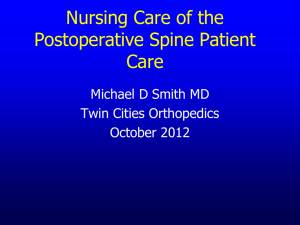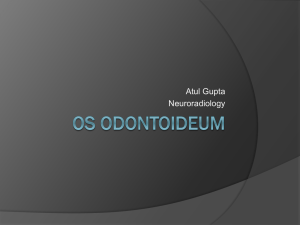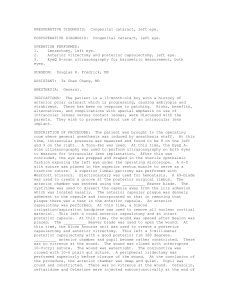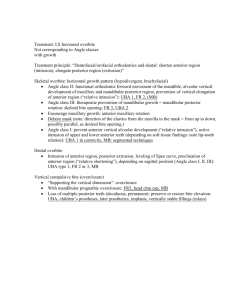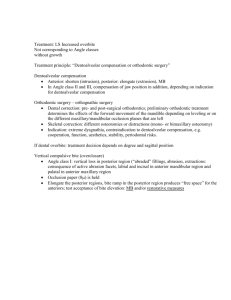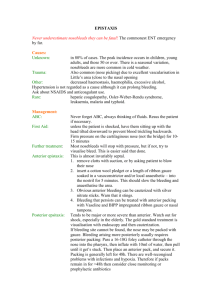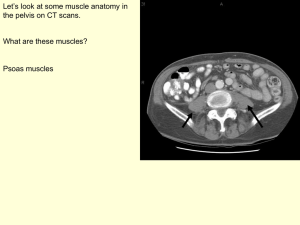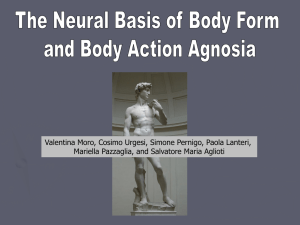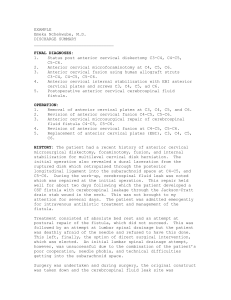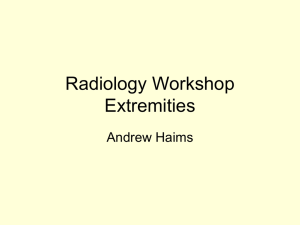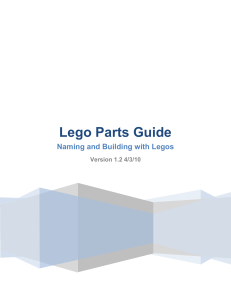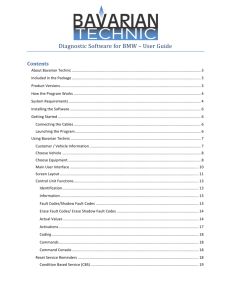Osseous M
advertisement
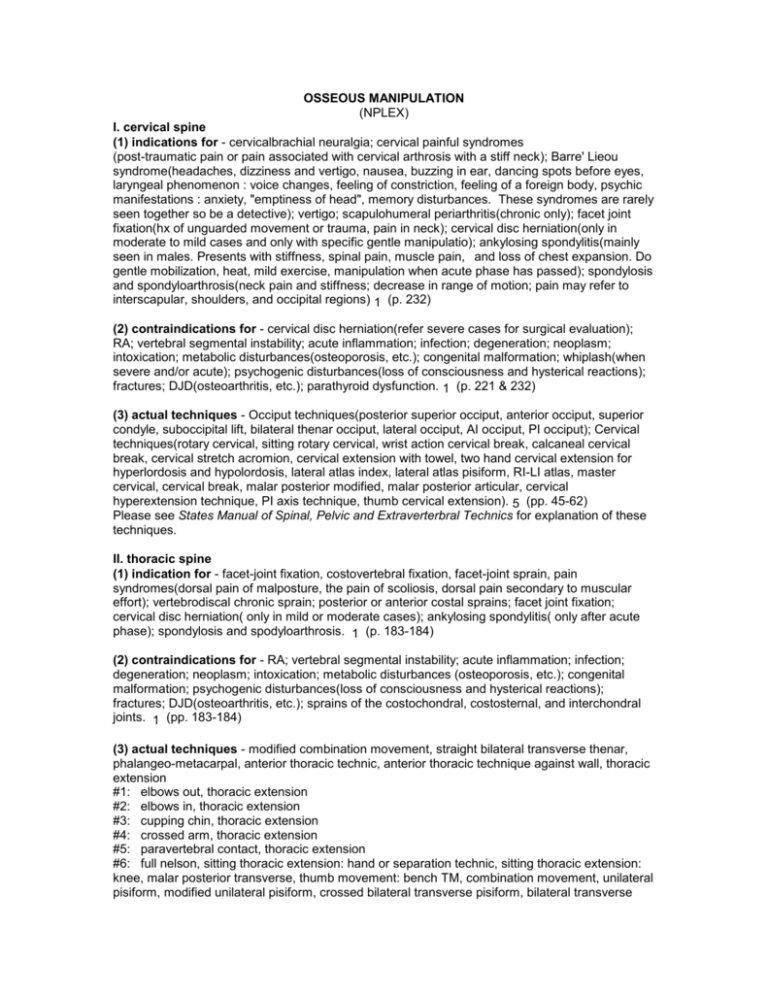
OSSEOUS MANIPULATION (NPLEX) I. cervical spine (1) indications for - cervicalbrachial neuralgia; cervical painful syndromes (post-traumatic pain or pain associated with cervical arthrosis with a stiff neck); Barre' Lieou syndrome(headaches, dizziness and vertigo, nausea, buzzing in ear, dancing spots before eyes, laryngeal phenomenon : voice changes, feeling of constriction, feeling of a foreign body, psychic manifestations : anxiety, "emptiness of head", memory disturbances. These syndromes are rarely seen together so be a detective); vertigo; scapulohumeral periarthritis(chronic only); facet joint fixation(hx of unguarded movement or trauma, pain in neck); cervical disc herniation(only in moderate to mild cases and only with specific gentle manipulatio); ankylosing spondylitis(mainly seen in males. Presents with stiffness, spinal pain, muscle pain, and loss of chest expansion. Do gentle mobilization, heat, mild exercise, manipulation when acute phase has passed); spondylosis and spondyloarthrosis(neck pain and stiffness; decrease in range of motion; pain may refer to interscapular, shoulders, and occipital regions) 1 (p. 232) (2) contraindications for - cervical disc herniation(refer severe cases for surgical evaluation); RA; vertebral segmental instability; acute inflammation; infection; degeneration; neoplasm; intoxication; metabolic disturbances(osteoporosis, etc.); congenital malformation; whiplash(when severe and/or acute); psychogenic disturbances(loss of consciousness and hysterical reactions); fractures; DJD(osteoarthritis, etc.); parathyroid dysfunction. 1 (p. 221 & 232) (3) actual techniques - Occiput techniques(posterior superior occiput, anterior occiput, superior condyle, suboccipital lift, bilateral thenar occiput, lateral occiput, AI occiput, PI occiput); Cervical techniques(rotary cervical, sitting rotary cervical, wrist action cervical break, calcaneal cervical break, cervical stretch acromion, cervical extension with towel, two hand cervical extension for hyperlordosis and hypolordosis, lateral atlas index, lateral atlas pisiform, RI-LI atlas, master cervical, cervical break, malar posterior modified, malar posterior articular, cervical hyperextension technique, PI axis technique, thumb cervical extension). 5 (pp. 45-62) Please see States Manual of Spinal, Pelvic and Extraverterbral Technics for explanation of these techniques. II. thoracic spine (1) indication for - facet-joint fixation, costovertebral fixation, facet-joint sprain, pain syndromes(dorsal pain of malposture, the pain of scoliosis, dorsal pain secondary to muscular effort); vertebrodiscal chronic sprain; posterior or anterior costal sprains; facet joint fixation; cervical disc herniation( only in mild or moderate cases); ankylosing spondylitis( only after acute phase); spondylosis and spodyloarthrosis. 1 (p. 183-184) (2) contraindications for - RA; vertebral segmental instability; acute inflammation; infection; degeneration; neoplasm; intoxication; metabolic disturbances (osteoporosis, etc.); congenital malformation; psychogenic disturbances(loss of consciousness and hysterical reactions); fractures; DJD(osteoarthritis, etc.); sprains of the costochondral, costosternal, and interchondral joints. 1 (pp. 183-184) (3) actual techniques - modified combination movement, straight bilateral transverse thenar, phalangeo-metacarpal, anterior thoracic technic, anterior thoracic technique against wall, thoracic extension #1: elbows out, thoracic extension #2: elbows in, thoracic extension #3: cupping chin, thoracic extension #4: crossed arm, thoracic extension #5: paravertebral contact, thoracic extension #6: full nelson, sitting thoracic extension: hand or separation technic, sitting thoracic extension: knee, malar posterior transverse, thumb movement: bench TM, combination movement, unilateral pisiform, modified unilateral pisiform, crossed bilateral transverse pisiform, bilateral transverse pisiform with torque, straight bilateral transverse pisiform, sitting thoracic extension: thigh, thumb transverse, crossed thumb transverse, covered thumb. 5 (pp. 63-90) III. lumbar spine (1) indications for - discal sciatica; facet-joint fixation(hx of unguarded movement, increased pain of extension, focal tenderness over affected facet joint; faulty posture, low back pain, radiation into groin, hip, buttock, and/or thigh); facet-joint sprain(hx of trauma, increased pain of extension, focal tenderness over affected facet joint, low back pain, radiation into groin, hip, buttock, and/or thigh) only if joint fixation is present; intervertebral disc herniation(pt usu. 30-50 yrs of age with episodes of low back pain, leg pain, or both) only in mild to moderate cases; spondylolisthesis(hx of childhood trauma or repeated infant falls, hyperextension injuries) manipulate directed at dysfunctional joints above and below, refer for surgery evaluation if unstable; acute paraspinal muscle strain(hx of trauma, repetitive bending, immediate transitory pain followed by pain free interval and subsequent stiffness, limited mobility and muscle spasm) short-lever manipulation. 5 (91-109) (2) contraindication for - facet joint sprain(if joint fixation is absent); intervertebral disc herniation(severe cases); transverse process fracture; vertebral compression fracture; spinous process fracture; unstable fractures; RA; vertebral segmental instability; acute inflammation; infection; degeneration; neoplasm; intoxication; metabolic disturbances(osteoporosis, etc.); congenital malformation; psychogenic disturbances(loss of consciousness and hysterical reactions); DJD(osteoarthritis, etc). 1 (149-151) (3) actual techniques - lumbar arm extension, lumbar mobilization with towel, transverso-ilio lift, transverso-genu, genu-deltoid(lumbar roll), talo-genu deltoid, lumbo-sacral stretch, spino-carpal, transverso-carpal, spino-brachial and transverso-brachial, transverso-brachial for disc lesions, transverso-deltoid, spino-deltoid, thigh transverso-deltoid, thigh spino-deltoid or knee spinodeltoid, unilateral pisiform recoil, bonyun's closing technic, bonyun's opening technic. 5 (pp. 91109). Please see States Manual IV. shoulder (1) indications for - shoulder dislocation; clavicular subluxations; adhesions within the glenohumeral joint; breaking up adhesions along the vertebral border of the scapula; rehabilitation of the serratus anterior; stretch and manipulate fibers of the trapezius muscle; bursitis; frozen shoulder; shoulder joint mobilization. 5 (pp. 198-213) (2) contraindications for - fractures; RA; intoxication; metabolic disturbances; psycogenic disturbances; neoplasm; infection; acute inflammation. 1 (pp. 67-68) (3) actual techniques - inferior humerus dislocation technic, Kocher's maneuver, pisiform clavicle, clavicle hook, general shoulder technic, prone shoulder circumduction, upper trapezius stretch, supine shoulder circumduction, inferior subluxated shoulder technic, sitting shoulder circumduction, acromioclavicular joint mobilization, sternoclavicular joint mobilization. 5 pp.198213). Please see States Manual V. knee (1) indications for - infrapatellar bursitis; chronic degenerative conditions; anterior and posterior subluxations of the tibia; adhesions of patella and patellar tendon; mild tears of the menisci; posterior fibula subluxations. 5 (pp. 168-179) (2) contraindications for - fractures; RA; intoxication; metabolic disturbances; psycogenic disturbances; neoplasm; infection; acute inflammation. 1 (pp. 67-68) (3) actual techniques - genu-stretch, AP draw, knee circumduction, general patellar technic, genu-circumduction extension technic, medial modified McMurray's technic, lateral modified McMurray's technic, general hip technic, posterior subluxated tibia technic, posterior subluxated fibula technic. 5 (pp. 168-179). Please see States Manual VI. foot and toes (1) indications for - fatigue and strains conditions; adhesions between metatarsal heads; tarsal adhesions; static congestion; edema; hallux valgus; mobilization of great toe; mobilize tibiltalo joint; plantar subluxations of the cuneiforms and navicular; mobilize cuneometatarsal and cubometatarsal joints; adhesions of metatarsophalangeal joints; pes plantus; elevating medial longitudinal arch; plantar subluxations of tarsal bones; adhesions of calcaneus. 5 (pp. 145-167) (2) contraindications for - fracture, ligamenteous strain, sprain or tear, tendinous strain, sprain or tear, infection, neoplasm, RA, osteoporosis, metabolic disorders. (3) actual techniques - general foot technic, metatarsal shear, modified metatarsal shear, foot figure eight, plantar compression. 5 (pp.145-167) Please see States Manual VII. ankle (1) indication for - stretch Achilles tendon; break adhesions of Achilles; sub acute inversion sprain; mobilize tibio-talo joint; congestion and adhesions of ankle; medial subluxation of talus. 5 (pp. 145-167) (2) contraindications for - fracture, ligamenteous strain, sprain or tear, tendinous strain, sprain or tear, infection, neoplasm, RA, osteoporosis, metabolic disorders. (3) actual techniques - foot figure eight, plantar compression, Achilles tendon technic, mortice shear, medially subluxated talus technic, general calcaneal technic. 5 (pp. 145-167). Please see States Manual VIII. elbow (1) indications for - extension fixations, mobilization of elbow into flexion, pronation, supination, lateral epicondylitis, posterior olecranon subluxation, anterior and posterior subluxations of the radial head. 5 (pp. 192-197) (2) contraindications - fracture, ligamenteous strain, sprain or tear, tendinous strain, sprain or tear, infection, neoplasm, RA, osteoporosis, metabolic disorders. (3) actual techniques - elbow mobilization in extension, elbow mobilization in pronation and supination, posterior olecranon technic, anterior subluxated radius technic, posterior subluxated radius technic. 5 (pp. 192-197). Please see States Manual IX. hip (1) indications for - anterior and posterior dislocations of femoral head, sciatic dislocations of femoral head. 5 (pp. 179-183) (2) contraindications for - fracture, ligamenteous strain, sprain or tear, tendinous strain, sprain or tear, infection, neoplasm, RA, osteoporosis, metabolic disorders. (3) actual techniques - anterior (obturator) dislocated femur technic, sciatic dislocated femur technic, posterior dislocated femur technic. 5 (pp. 179-183) Please see States Manual X. sacrum (1) indications for - anterior sacrum, posterior sacrum, right anterior inferior sacrum, left anterior inferior sacrum, right posterior inferior sacrum, left posterior inferior sacrum. 5 (pp. 131-143) (2) contraindications for - RA; acute inflammation; infection; degeneration; neoplasm; intoxication; metabolic disturbances(osteoporosis, etc.); congenital malformation; psychogenic disturbances(loss of consciousness and hysterical reactions); fractures; DJD(osteoarthritis, etc.), acute or severe ankylosing spondylitis. 1 (pp. 67-78) (3) actual techniques - lower sacral thrust: calcaneal, bigenu - sacral deltoid modified, sacral genu knee chest drop: bilateral, apex contact (three-minute), thigh sacral deltoid, lower sacral thrust: unilateral, sacral-ilio cross, posterior sacrum, RPIS-LPIS technic. 5 (pp. 131-143). Please see States Manual XI. hand and fingers (1) indications for - adhesions between metacarpal heads, mild case of degenerative and RA in hand, mobilization of arthritis pt's, degeneration of MP or CP joints, mobilization of the thumb. 5 (pp.184-191) (2) contraindications for - fracture, ligamenteous strain, sprain or tear, tendinous strain, sprain or tear, infection, neoplasm, osteoporosis, metabolic disorders. (3) actual techniques - metacarpal shear, rotary finger technic, policis mobilizing technic, carpal back bend. 5 (pp.184-191). Please see States Manual XII. wrist (1) indication for - mobilization of wrist, slight swelling due to pain and trauma, degenerative changes, anterior and posterior carpal subluxations, carpal tunnel syndrome. 5 (pp. 184-191) (2) contraindication for - fracture, ligamenteous strain, sprain or tear, tendinous strain, sprain or tear, infection, neoplasm, osteoporosis, metabolic disorders. (3) actual techniques - general wrist technic, subluxated carpal technic, carpal syndrome technic. 5 (pp.184-191). Please see States Manual tunnel XIII. coccyx (1) indications for - anterior, right anterior, left anterior sacrum. 5 (p. 141) (2) contraindications for - RA; acute inflammation; infection; degeneration; neoplasm; intoxication; metabolic disturbances(osteoporosis, etc.); congenital malformation; psychogenic disturbances(loss of consciousness and hysterical reactions); fractures; DJD(osteoarthritis, etc.), acute or severe ankylosing spondylitis. 1 (pp.67-68) (3) actual techniques - external coccygeal, internal coccygeal. 5 (p. 141) Please see States Manual
